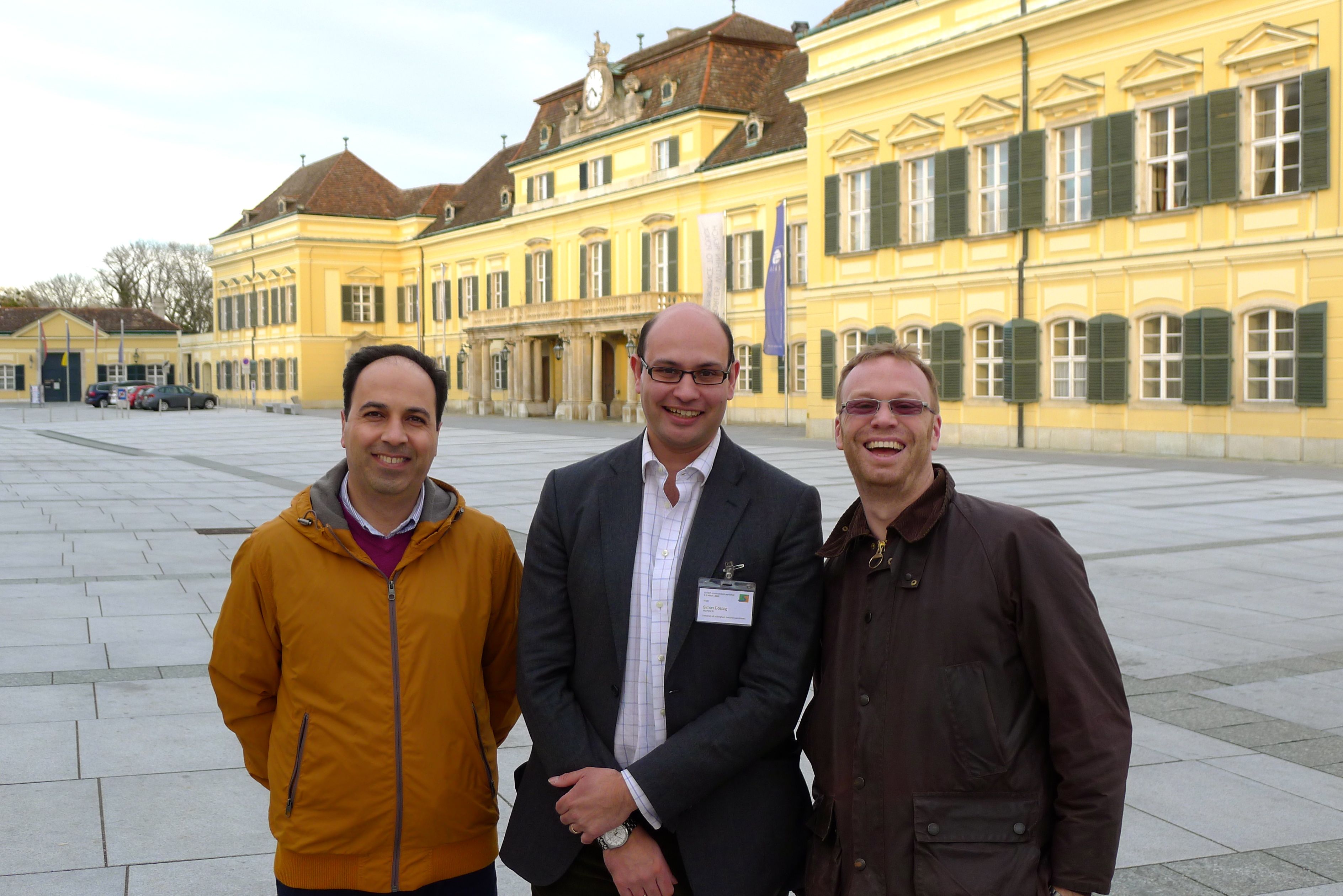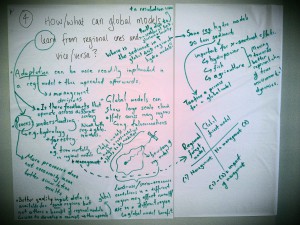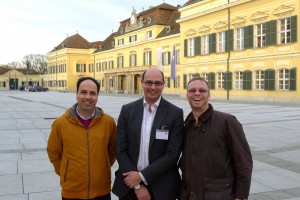
March 5, 2015, by Simon Gosling
Answering the big questions in climate change impacts science
This week, a team of environmental modellers from the School of Geography have been presenting their research at a major workshop on modelling climate change imapcts, at the International Institute for Applied Systems Analysis (IIASA), in Laxenburg, Austria.
The team comprises of Dr Simon Gosling (Associate Professor of Climate Risk), Dr Nick Mount (Associate Professor of Hydroinformatics) and Mr Jamal Zaherpour (PhD candidate funded by the Islamic Development Bank and supervised by Simon and Nick).
The workshop is the second phase of an extensive international project, ISI-MIP. ISI-MIP stands for “The Inter-Sectoral Impact Model Intercomparison Project” and it is a community-driven modelling effort bringing together impact models across sectors and scales to create consistent and comprehensive projections of the impacts of different levels of global warming. The sectors include water resources, crops, biodiversity, energy, and forestry. ISI-MIP brings together researchers from across 30 institutions in over 90 cities. Simon is one of the project co-ordinators for the water sector and he co-authored the experimental design for the project.
The workshop has been building upon progress from the first stage of the project, which culminated in 11 articles in a Special Issue of the journal PNAS in 2014 and several citations in the Fifth Assessment Report (AR5) of Working Group II of the Intergovernmental Panel on Climate Change (IPCC), a significant document that is used for informing policy-making processes on global climate change. The workshop has been answering questions such as; what are the possible impacts of climate change, how much agreement is there between projections from different impacts models, and how can we better represent links between different sectors in the models?
The team from the School of Geography have been presenting innovative techniques for combining results from the many models that are submitting results to the ISI-MIP project.
One of the first things you are aware of when you attend an international model inter-comparison project workshop is just how many models are out there, and how many sectors are engaged in modelling the impacts of climate change. For example, in the water sector of ISI-MIP there are fourteen different models that are designed to provide combined spatial / temporal projections of how runoff will be impacted by climate change across the globe. Scientists concerned with projecting the impacts of climate change on agricultural production have created a similar number of models – as have those concerned with energy, biodiversity, forestry, marine productivity. With such a diverse array of models differences between the individual projections that their outputs provide is inevitable. This uncertainty is a big issue for two key reasons.
Firstly, it is difficult to decide what to do to tackle the impacts of climate change when there are significant differences – even disagreements – in the model outputs that must be relied upon to inform the decision. Secondly, the outputs of models from one sector are often needed as inputs to the models of another. For example, the outputs of global runoff models provide important inputs to agricultural production models (irrigation for agriculture is the largest consumer of water), and energy models (think about hydro-power or the importance of water within fossil-fuel based power plants). The efficiency of such ‘inter-sectoral’ model applications can be improved if there is a single model output that can be made available for transfer from one sector to another alongside the individual models. The net result of all this is a need for effective and robust methods that can bring the multiple outputs from different models together into one combined output. This combined output should be an improvement over any of the individual models.
Of course, at a very simplistic level, it is possible to combine model outputs using very simple techniques – for example taking the mean of the different model outputs that are available. However, by doing this you lose information from the models – the mean value masks what is actually going in the individual models. The mean also gives the same weight to each model – the influence of a ‘bad’ model output on the mean value is just as great as that of a ‘good’ one. It is, therefore, highly unlikely that the mean of the model outputs will be an improvement over the best individual models. What is needed are combination equations that combine model outputs in ways that mean they are better than any individual model. To do this, it is necessary to find combination methods that emphasise the best bits of the best models, whilst removing the worst bits of the worst models. It is a solution to this problem that the University of Nottingham team have been presenting at the ISI-MIP workshop.
Our approach involves using novel intelligent computing methods to generate mathematical equations for combining the model outputs. Specifically, we utilise Darwinian principles that are more commonly associated with biologists and apply them through ‘evolutionary’ algorithms. These algorithms breed equations that can then be used to define how each of the different model outputs should be combined together. The approach can be understood by thinking of the combination equations as ‘organisms’ whose genetic blueprint consists of a string of mathematical elements (e.g. simple arithmetic operators or more advanced numerical functions) and inputs from the different models that must be combined. The job of these equation organisms is to try to survive in an environment. This environment can be thought of as the set of observations that must be reproduced. In order to survive, the equation organism must combine the models in ways that deliver a strong reproduction of the observations.
To achieve this, an evolutionary algorithm firstly breeds several equation organisms, and tests how well each is suited for surviving in the environment. It then kills off those equation organisms that are not well suited to surviving because their genetic information emphasises the role of ‘bad’ models. However, it keeps those that are well suited to surviving (think survival of the fittest), and then breeds them together by transferring their genetic blueprint amongst them – producing a new generation of equation organisms. In this way, the characteristics of the best equation organism are passed on and on through lots of generations and an equation organism is ultimately evolved that is highly suited to surviving in its environment (i.e. reproducing the observations). Because of the way it has been generated, the parameters of this final, multi-model combination equation will define how to combine the outputs from different models together in a way that draws on, and emphasise the best bits of the best models and ignores the worst bits of the worst models.
At ISI-MIP, the Nottingham team have been reporting their use of this multi-model combination approach. The team has combined the outputs of seven separate global hydrology models that have been set up to deliver a historical reproduction of runoff patterns in 110 catchments located across the globe. The results of this combination effort are highly encouraging. The technique has delivered combined model outputs that are better than any individual model in 90% of the catchments analysed and has resulted in a combined model output with an average 30% improvement over the best single model. The work was received very positively by the ISI-MIP scientific community who recognised that the research is going a long way to meeting the need for effective and robust methods that can bring the multiple projections from different models together into one combined and improved projection.






Thank you very much dear Simon for this input.
Regards, Jamal